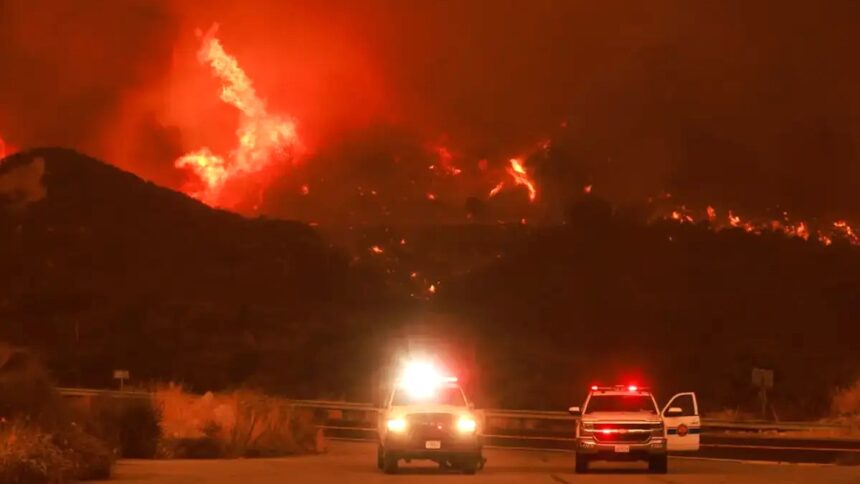A devastating brush fire, known as the Line Fire, has erupted near Highland in San Bernardino County, California, burning over 17,000 acres and prompting widespread evacuations. With scorching temperatures exacerbating the crisis, emergency measures are in full swing to combat this growing disaster.
Fire Grows Exponentially, Forces Evacuations
As of early Sunday morning, the Line Fire has exploded to over 17,000 acres, a dramatic increase from the 3,800 acres reported just the previous day. The rapid expansion of the fire, fueled by extreme heat and dry conditions, has led to mandatory evacuation orders for thousands of residents. Areas under evacuation include:
All of Running Springs
All of Arrow Bear Lake
The region east of Orchard Road to Cloverhill, from Highland Avenue north to the foothills in Highland
Authorities estimate that approximately 8,733 structures are threatened by the blaze, which remains completely uncontained.
#BREAKING
A state of emergency has been declared in San Bernardino to support crews fighting the #LineFire now over 7,100 acres.
Efforts ramp up to protect communities and contain the blaze.
#CaliforniaFires #WildfireAlert #Wildfire #SanBernardino #BreakingNews #California pic.twitter.com/fd6bani8ba
— Mr. Shaz (@Wh_So_Serious) September 8, 2024Emergency Declaration and Federal Support
In response to the escalating situation, California Governor Gavin Newsom has declared a state of emergency in San Bernardino County. This declaration enables the government to expedite aid and provide crucial resources to those affected. It also allows for the waiver of certain regulations, facilitating quicker access to unemployment benefits and replacement of vital documents like marriage and birth certificates.
Furthermore, the state has secured a Fire Management Assistance Grant from FEMA. This grant covers up to 75% of local firefighting costs, providing essential financial relief to local agencies battling the blaze.
Governor Newsom expressed gratitude to President Biden for the prompt federal support and urged residents in the impacted areas to stay vigilant and ready to evacuate if necessary.

Air Quality Deteriorates Amidst the Flames
The Line Fire is also significantly impacting air quality in the region. The South Coast Air Quality Management District reports that pollutants are approaching “Very Unhealthy” levels near the fire. For a broader area of Southern California, air quality is expected to reach “Unhealthy for Sensitive Groups” at times, due to elevated levels of fine particle pollution from the wildfire smoke.
Record Heat Intensifies the Crisis
Adding to the severity of the fire, Southern California is experiencing an intense heat wave. Temperatures are soaring between 95 and 105 degrees Fahrenheit, exacerbating the fire risk and making firefighting efforts even more challenging. The National Weather Service has issued excessive heat warnings and red flag alerts, signaling conditions that may result in extreme fire behavior.
Fire Creates Its Own Weather Patterns
The Line Fire has become so intense that it is creating its own weather patterns. Known as pyrocumulus clouds, these formations can produce erratic winds and even lightning, further complicating efforts to control the blaze. In extreme cases, these clouds can lead to pyrocumulonimbus activity, generating thunderstorms and intensifying the fire’s spread.
Impact on Local Communities and Emergency Response
Residents in affected areas are facing harrowing conditions. Some have been forced to evacuate their homes, while others are attempting to protect their properties. For instance, Highland resident Brian Gano and his family used a high-pressure hose to fight the flames encroaching on their home. Meanwhile, local authorities have established evacuation shelters, including one at a local church, to provide refuge for displaced residents.
Firefighters from multiple agencies, including Cal Fire, San Bernardino County Fire, and the San Bernardino County Sheriff’s Department, are working tirelessly to control the fire. However, steep terrain and limited access areas are hindering their efforts. As of the latest reports, around 500 firefighters are engaged in the battle, but containment remains elusive.
Additional Fires and Disruptions
The wildfire crisis is compounded by other active fires and disruptions. The Davis Fire, south of Reno, Nevada, has burned approximately 1,500 acres and destroyed at least six structures. It remains 0% contained as of Sunday morning. Additionally, two earthquakes struck near Ontario, California, adding to the region’s challenges.
Statewide Fire Activity and Preparedness
California is experiencing an exceptionally active fire season, with over 838,000 acres burned so far this year, a significant increase compared to the 255,144 acres burned by this time last year. The state’s fire management efforts are in full swing, but the combination of extreme heat, dry conditions, and persistent wildfires continues to pose a severe threat.
In summary, the Line Fire has rapidly grown into a major disaster, affecting thousands of residents, deteriorating air quality, and challenging emergency responders. With record heat and the potential for further fires, the situation remains critical, and residents are urged to stay informed and prepared for ongoing developments.
Read More : Kentucky Highway Shooting Sparks Manhunt for Armed Suspect






